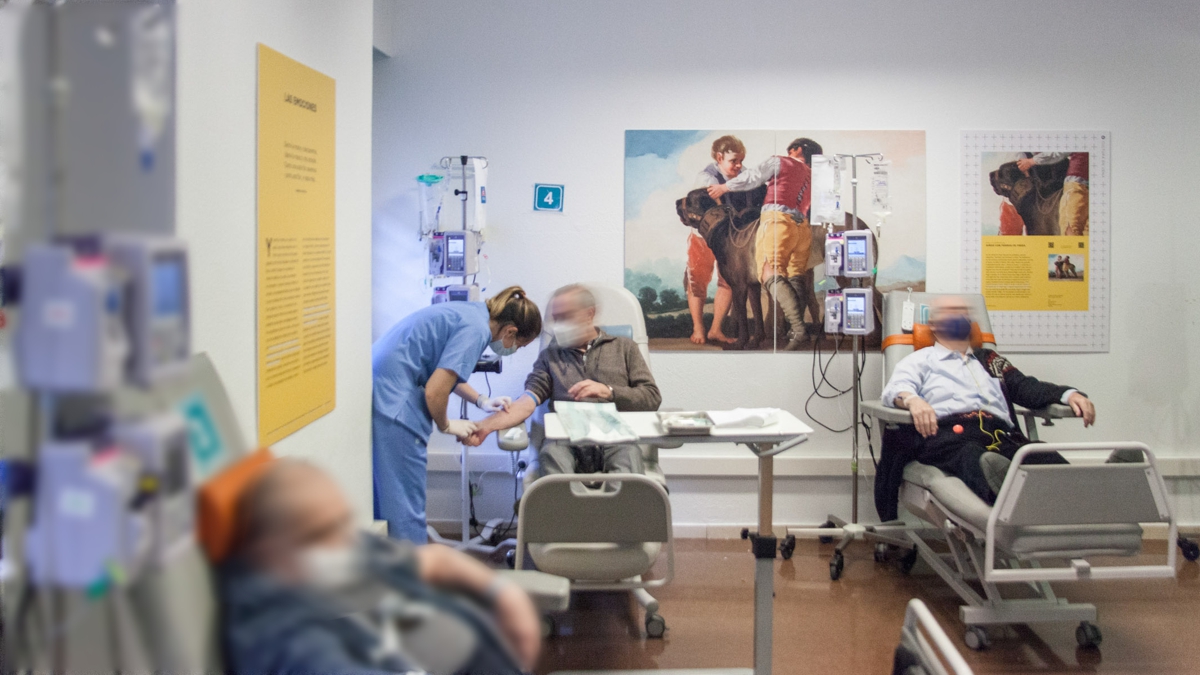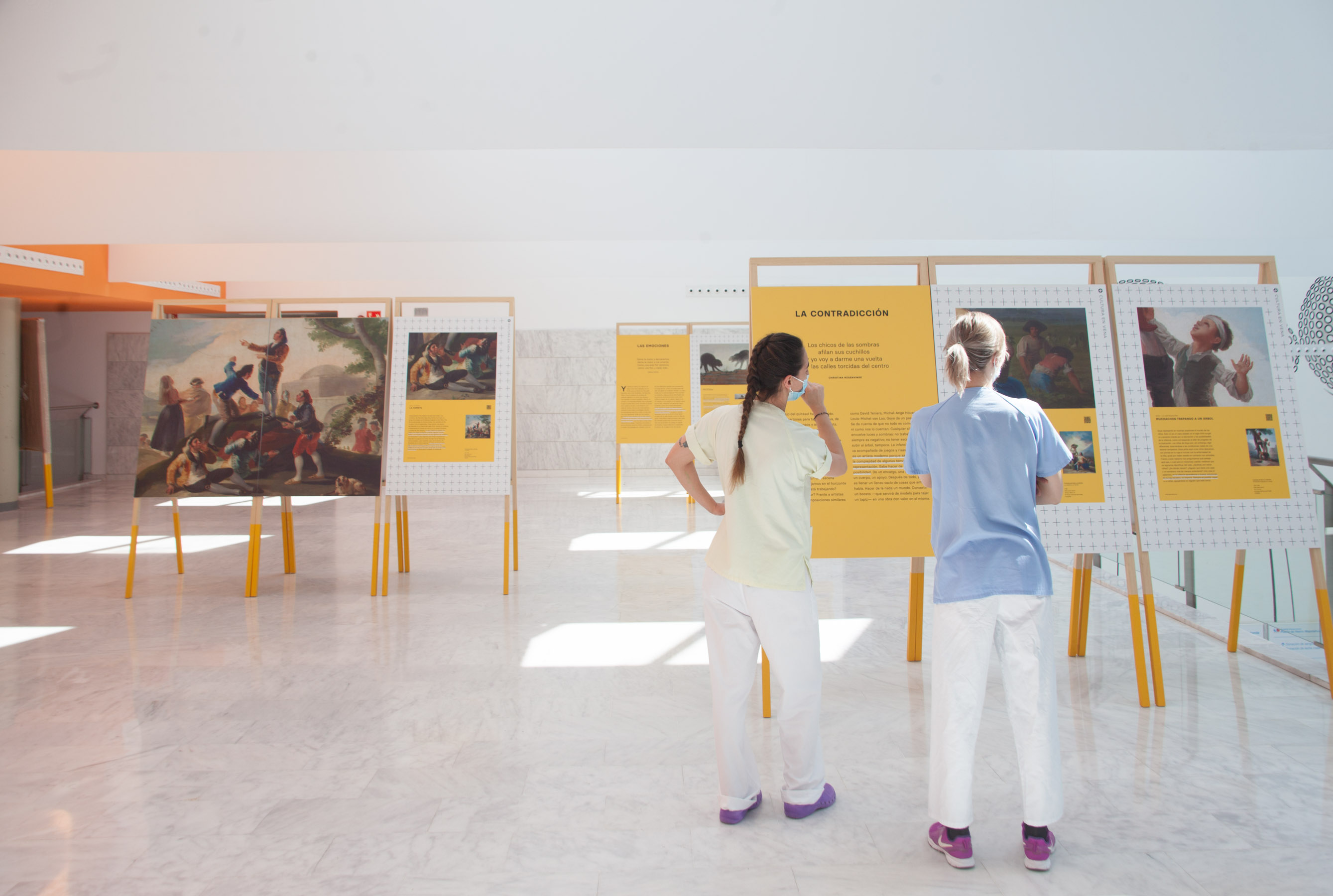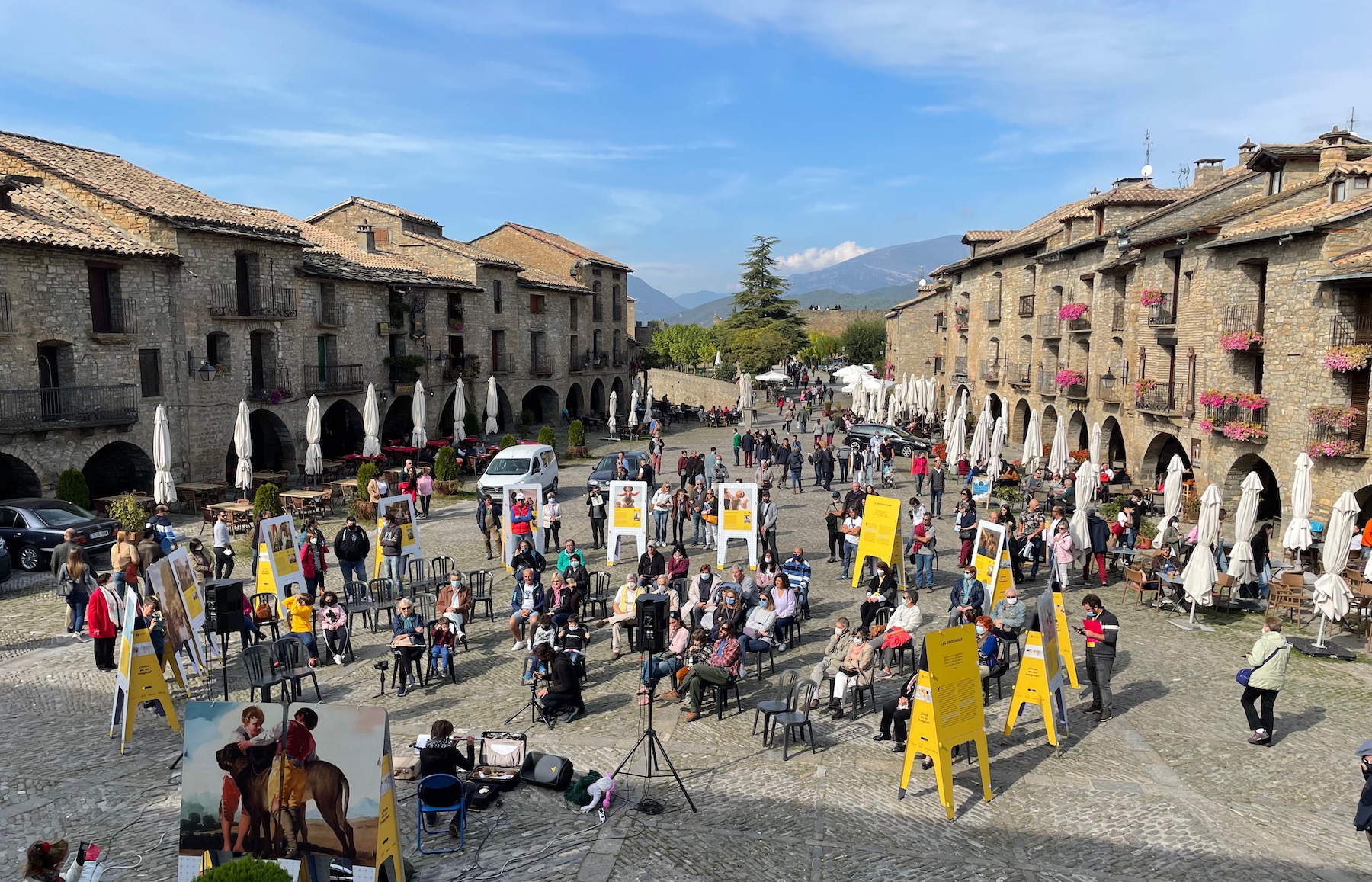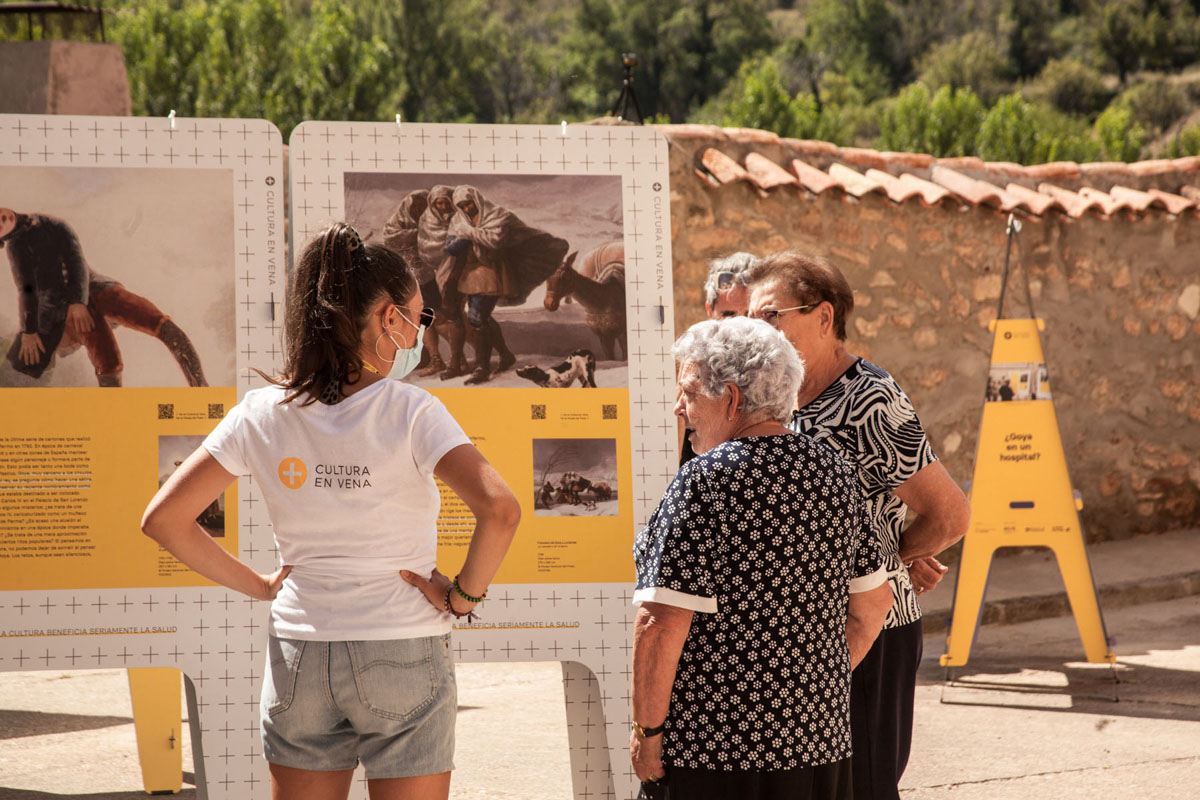At Cultura en Vena we believe that culture seriously benefits your health. We bring the arts into places they usually don’t reach —hospitals and rural villages at risk of depopulation. In 2021 we launched our Ambulatory Art Program in different hospitals and small villages in Aragón, Spain. Three different art exhibitions were shown —Francisco de Goya, comics about the covid, and European young artists’ creations for hospitals, together with a folk music festival in rural areas.
During 2021 the Cultura en Vena Foundation launched the Ambulatory Art Program, an art tour visiting hospitals and six small villages at risk of depopulation in the region of Aragón (Spain), consisting of art practices connecting arts and music with health and well-being.
We showed three different exhibitions especially curated and designed for patients in hospitals and inhabitants of rural areas:
- Goya in a hospital? With high-quality copies of works by Francisco de Goya (1746-1828, a native of Aragón) whose copyrights were granted by the Prado Museum. The curatorship was prepared by cultural mediators from the innovative perspective of health and well-being.
- Side effects. 19 covid comics. Commissioned during the 2020 lockdown to comic artists to reflect on the pandemic and the problems worsened by it, such as the treatment of the elderly, social inequalities or the imminent environmental crisis.
- Emergency Culture. Featuring young European artists during the pandemic. Our goal was to stimulate art projects highlighting the transformational role of culture in the field of health and well-being, in order to be shown in hospitals.
For us it is a priority that the exhibitions are accessible to all audiences —therefore we hired cultural mediators to help communicate their contents as they were conceived.
To accompany the exhibitions, we organized a folk music festival inspired by Goya's country and costumbrist scenes —only in rural areas due to covid situation.
The impact of Ambulatory Art Program was the following (see below the impact field for more details):
-3 exhibitions in main hospitals
-1,742,500 estimated beneficiaries (patients, visitors and healthcare staff)
-200+ young European artists participated
-6 rural villages in Aragón (Spain): Las Parras de Martín, Pancrudo, Uncastillo, Villanueva de Sijena, Aínsa and Cuevas de Cañart
-12 exhibitions shown
-9 concerts organized
-16 musicians hired
-10 cultural mediators hired
-1499 people attended
Please highlight how the project can be exemplary in this context
The Cultura en Vena Foundation was selected as exemplary project committed to the Sustainable Development Goals (2021 Observatory of Culture of the Contemporánea Foundation, Spain).
Ambulatory Art Tour met this SDGs:
SDG 3 Good health and well-being
We adhere to the latest guidelines of the World Health Organisation (November 2019), a report supported by 900 scientific studies on the positive role of the arts in health and well-being.
Arts in rural areas prevent unwanted solitude —a genuine public health problem. The country scenes of Goya had a therapeutic effect on the elderly, who remembered their childhood and liberated emotions associated with it, generating a sense of belonging.
Through comic commissions, we promoted financing and a support program for artists to collaborate with health strategies.
SDG 4 Quality education
Through the arts, we offered high quality and inclusive learning opportunities to people of all ages without easy access to cultural activities.
SDG 8 Decent work and economic growth
We encourage the social and economic reactivation of rural areas and sustainable and conscious tourism.
For the rural tour we employed artists, musicians, cultural mediators, coordinators and video makers, and stimulated the art industry with the production of exhibition materials.
SDG 11 Sustainable communities
We guaranteed the cultural rights of vulnerable groups such as the inhabitants of depopulated areas.
Through art (Goya’s scenes) we promoted maintenance of collective memory and ancestral knowledge as common heritage.
SDG 12 Responsible consumption and production
During the project, all the materials were transported in the same vehicle used by the project coordinators, who also spent the night in the same adapted vehicle.
Thanks to our innovative reversible easel design, two exhibitions were shown amortizing efforts and saving on energy, consumption and production. Single-use materials were minimized and recycled correctly.
Please highlight how the project can be exemplary in this context
Aesthetics is important to us —our founders are an architect and art exhibitions designer, and a concert pianist with 20 year-long experience in the European arts industry. We believe that culture seriously benefits your health, so we only offer high-quality art experiences to those who most need them.
Goya in a hospital? exhibition shows high-resolution copies of works by one of the great artists of all times, Francisco de Goya, whose copyrights were granted by the Prado Museum. Our curatorship was specially prepared for patients, healthcare staff and inhabitants of rural areas at risk of depopulation. It included country and costumbrist scenes featuring children from the cartones (preparatory paperboards) Goya painted for the Royal Tapestry Factory commissioned by Carlos III in order to decorate his palace with “jocular and pleasant topics”.
We intervened in hospital halls, waiting areas, day hospital and patient rooms. The reception was optimal —art humanizes healthcare and improves the patient’s stay and the staff's work environment.
In rural areas we showed two different art contents thanks to our reversible easel design. This way a community can benefit from two exhibitions in two days in a row —an example of cultural sustainability.
The exhibition Side effects. 19 comics about covid shows a rich variety of illustration styles by the best Spanish cartoon creators —including National Awards artists. Nowadays, comics are highly appreciated as an educational tool in the field of health by the international graphic medicine movement.
Through accessible explanations to all audiences, cultural mediators generated an exceptional aesthetical experience which made a deep imprint on people in small villages.
We are specialists in connecting music to visual arts. Folk music concerts accompanied the exhibitions, since scientific evidence shows multiple benefits of music to our health and well-being, which also strengthen the sense of community and belonging.
Please highlight how the project can be exemplary in this context
We firmly believe that art is an engine of social change, therefore universal accessibility is a priority for us. Patients and healthcare are vulnerable groups who go through stressful situations, specially in pandemic times —so we believe arts need to surround them, since hospitals are usually excluded of the cultural programs of the cities.
By employing local cultural mediators we give a job opportunity to people in small villages. We also encourage inter-generational exchange, since most of the mediators are under 30, who will dialogue with the locals—mostly older people. This connection, usually broken by the pandemic, helped to share traditional knowledge and contributed to legacy transmission.
Offering two exhibitions guaranteed reaching a wider range of audiences, since the comic one was crucial to attract youth. Through the accessible and affordable medium of cartoons, children and young people have been able to share their experiences about pandemic times.
All the artworks had a QR code linked to the Prado Museum and Cultura en Vena websites, therefore facilitating cultural contents to patients and encouraging digital literacy of the elder.
Citizen collaboration was a key factor. Local people were involved from the beginning in setting up the exhibition, assembling the 16 free-standing easels installed outdoors and helping with logistical issues.
The folk concerts were also designed for all audiences. They not only included a presentation, but also the musicians themselves introduced the music. They explained the rhythmic and melodic aspects in an entertaining, understandable way, showing the characteristics of traditional instruments. A special concert included popular songs inspired by each of the Goya’s paintings —many of them referred to ancient games and were interactive, offering the opportunity for children and adults to participate collectively.
Soon we will release a documentary clearly showing this inclusive citizen participation.
Please highlight how this approach can be exemplary
The triangle of values that encompass sustainability, aesthetics and inclusion are at the base of the Cultura en Vena foundation, and therefore are reflected in the Ambulatory Art Tour.
Displaying artworks in a hospital gives an unique opportunity of solace through an aesthetic experience to a vulnerable group such as patients and healthcare staff.
By bringing the beauty of art to a small town at risk of depopulation, we are providing an unforgettable and inclusive aesthetic event to a group that is also at risk of exclusion, for not having easy and frequent access to culture.
By using the same display materials in different rural locations, we are promoting the sustainability of the project in environmental terms and being inclusive of neglected rural areas.
We have combined sustainability with a double aesthetic experience, by including two exhibitions in one. This offers the opportunity to enjoy and learn from two artistic currents from different periods, styles and messages, combined with savings in costs, energy, production and consumption.
In hospitals, we make the exhibitions sustainable by leaving them for six months before touring to another hospital, which exponentially multiplies the number of beneficiaries to thousands.
Inclusion and aesthetic experience have been blended thanks to cultural mediation in the exhibitions, which have made it possible for all audiences to access two original and unique artistic contents, especially curated for these audiences.
The folk concerts have also combined all three elements, as they have been sustainable by hiring the same musicians in some nearby towns. Furthermore, they have provided a unique, affordable, and participatory musical aesthetic experience for people of all ages, social classes, and educational backgrounds.
The impact and beneficiaries of the Ambulatory Art program in hospitals between March and December 2021 was the following:
-3 main hospitals: Puerta de Hierro and Clínico San Carlos Hospitals (both in Madrid) and Miguel Servet (Zaragoza).
-1,742,500 estimated beneficiaries (patients, visitors and healthcare staff)
The impact and beneficiaries of the Emergency Culture exhibition, including the previous call for artists held in June-November 2020, was the following:
-More than 200 young artists between ages 18 and 35 of visual arts and micro-literature participated
-11 European countries of origin: Austria, Belgium, Finland, France, Germany, Greece, Italy, The Netherlands, Portugal, Spain and the United Kingdom.
-8 winner + 22 finalist artworks were selected to tour in hospitals
-8,000 € in prizes were awarded
-68,193 estimated beneficiaries (patients, visitors and healthcare staff)
The impact and beneficiaries of the Ambulatory Art tour in rural areas, held between August and October 2021, was the following:
-Six villages at risk of depopulation in Aragón (Spain) were visited
-Las Parras de Martín (17 registered inhabitants)
-Pancrudo (119 registered inhabitants)
-Uncastillo (650 registered inhabitants)
-Villanueva de Sijena (394 registered inhabitants)
-Aínsa (2151 registered inhabitants)
-Cuevas de Cañart (70 registered inhabitants)
-12 exhibitions were shown (2 different contents in each village)
-9 concerts were organized
-16 musicians were hired
-10 cultural mediators were hired (mostly local, when possible)
-941 people visited the exhibitions
-558 people attended the concerts
A video documentary is about to be released, which covers all the locations of the tour showing the impact and reception of the project both in hospitals and rural environments.
Please also explain the benefits that derived from their involvement.
In order to build the Emergency Culture exhibition, we launched a European call for artists in order to stimulate artistic creation reflecting on the role of arts in health and well-being. More than 200 young artists from 11 countries participated, and 30 artworks were selected to be exhibited in hospitals.
To find native cultural mediators for the rural areas, we contacted local councils and associations. A training webinar was held, and candidates collectively collaborated in designing an approach strategy.
Furthermore, we selected a local coordinator from action groups or councils to facilitate coordination in each town. They informed the neighbors and helped to prepare everything necessary for the organization.
The villagers were involved from the first moment, helping with the assembly of the exhibitions and collaborating in all logistical needs. A family, collaborative and community environment was created —difficult to generate in large cities, but easy in small towns.
The small local business advertised the tour, and their economy benefited from the influx of visiting people from the surrounding areas.
The elderly had the opportunity to participate in the documentary of the project, appearing in front of the cameras for first time in their lives. Remembering childhood memories thanks to Goya (also a native of Aragón) generated a stronger feeling of belonging.
In Las Parras de Martín, half the population (17 registered!) dressed in traditional costumes from Goya’s era (18th century) featured in the paintings, and performed traditional dances.
The concerts allowed for interactive actions with the participation of audiences of all ages. Some traditional games were performed to the rhythm of the music —hand percussion on a table, traditional recitation on stilts, or the “manteo del pelele”.
We care about recording the impact of these actions, so a measurement was carried out through surveys of local inhabitants to monitor the reception of the project.
The Cultura en Vena Foundation was selected as exemplary project committed to the Sustainable Development Goals (2021 Observatory of Culture of the Contemporánea Foundation, Spain).
Ambulatory Art Tour met this SDGs:
SDG 3 Good health and well-being
We adhere to the latest guidelines of the World Health Organisation (November 2019), a report supported by 900 scientific studies on the positive role of the arts in health and well-being.
Arts in rural areas prevent unwanted solitude —a genuine public health problem. The country scenes of Goya had a therapeutic effect on the elderly, who remembered their childhood and liberated emotions associated with it, generating a sense of belonging.
Through comic commissions, we promoted financing and a support program for artists to collaborate with health strategies.
SDG 4 Quality education
Through the arts, we offered high quality and inclusive learning opportunities to people of all ages without easy access to cultural activities.
SDG 8 Decent work and economic growth
We encourage the social and economic reactivation of rural areas and sustainable and conscious tourism.
For the rural tour we employed artists, musicians, cultural mediators, coordinators and video makers, and stimulated the art industry with the production of exhibition materials.
SDG 11 Sustainable communities
We guaranteed the cultural rights of vulnerable groups such as the inhabitants of depopulated areas.
Through art (Goya’s scenes) we promoted maintenance of collective memory and ancestral knowledge as common heritage.
SDG 12 Responsible consumption and production
During the project, all the materials were transported in the same vehicle used by the project coordinators, who also spent the night in the same adapted vehicle.
Thanks to our innovative reversible easel design, two exhibitions were shown amortizing efforts and saving on energy, consumption and production. Single-use materials were minimized and recycled correctly.
In recent years thousands of clinical studies have furnished scientific proof about the positive effect of culture on health. Both the WHO and Spanish institutional frameworks recommend the implementation of arts interventions in healthcare policies. All this legitimises the creation of a totally new and highly productive sector of activity: culture and health.
We offer an innovative perspective of our artistic heritage by working on the benefits of culture in health. In example: the Goya in a hospital? exhibition provides a QR code linked to the Prado Museum website containing all the artwork technical information. However art offers multiple readings, therefore we commissioned cultural mediators special texts with the aim of connecting Goya’s paintings to four topics on human nature—humor, emotions, contradiction and challenges. These are aspects that become key factors when going through a difficult health process, or a situation of vulnerability.
This approach builds a fresh and new relationship between art, audiences and healthcare and rural settings. The aim is to bring specially curated cultural contents to people who are usually neglected by the mainstream cultural system, which concentrates art events only in urban areas.
Cultural and governmental institutions begin to be aware of their responsibility and possibility of contributing from their mainstream programming to the health and well-being of citizens, as dictated by the WHO. In Spain Cultura en Vena leads this intersection of art and health, and seeks to achieve a transversal agreement between institutions and sectors to make art an essential and daily good in hospitals and rural areas.
Unlike other countries, the presence of the arts is not established in Spanish hospitals. In addition, depopulation is currently one of the most worrying problems in our country — some geographic areas have the lowest population rates in Europe. Therefore, we believe that our mission is innovative and necessary.
Please provide clear documentation, communication of methodology and principles in this context.
Currently, the Fundación Cultura en Vena is one of the Spanish references in the connection between the sectors of art, health and social impact. However, we understand leadership as an opportunity to create collaboration networks and organizations that work with art as an agent of social change and improvement of health and well-being.
In regard to hospital environments, our spirit of collaboration drives us to share learning for the common good. An example of this is related with our research project on the effects of live music on different pathologies. After three years of clinical research employing professional musicians to perform in hospitals, currently we are writing a white-book collecting all the know-how we learned about the implementation of music practices in healthcare settings. We do this in order to be able to scale the project to the entire Spanish hospital network —and this example can be extrapolated to the Ambulatory Art program.
On the other hand, we do not understand the Ambulatory Art rural tour as an isolated action, conceived from the city (we are currently located in Madrid) —which could be interpreted as a gesture of superiority from an urban environment towards depopulated areas. For us it is essential to create lasting links with the communities, to generate roots —we want to contribute to creating a network of organizations aligned with our philosophy.
With this objective we have designed the Ambulatory Art tour, a prototype of action in 6 specific villages affected by depopulation which we wish to share in order to form a network of small towns throughout Spain, in which local associations, foundations and government agents collaborate in a horizontal, non-hierarchical structure, with whom we will share our experiences and learning.
Please see methodology in the attached dossier Culture seriously benefits your health, in the section How do we carry out our Ambulatory Art program? .
We attach three documentation files:
1. A general dosier of the Cultura en Vena foundation, which explains our work on the interaction between art, health, well-being and social transformation. It encompasses our two main areas of action — hospitals and rural villages. (In English)
2. A specific dosier of the Ambulatory Art project with pictures of the complete tour, including an impact measurement with the numbers of benefitted people in each village (in Spanish).
3. A press release of the call-for-artists for the Emergency Culture exhibition, with attached images of the resulting display with winner and selected artworks in the San Carlos Hospital (Madrid). (In English).






@Cultura en Vena Foundation, 2021
Content licensed to the European Union.